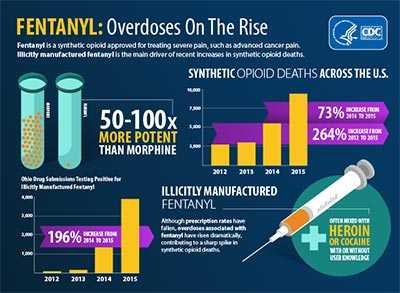Fentanyl

What is fentanyl?
Pharmaceutical fentanyl is a synthetic opioid pain reliever, approved for treating severe pain, typically advanced cancer pain.1 It is 50 to 100 times more potent than morphine. It is prescribed in the form of transdermal patches or lozenges and can be diverted for misuse and abuse in the United States.
However, most recent cases of fentanyl-related harm, overdose, and death in the U.S. are linked to illegally made fentanyl.2 It is sold through illegal drug markets for its heroin-like effect. It is often mixed with heroin and/or cocaine as a combination product—with or without the user’s knowledge—to increase its euphoric effects.
Illicitly-made fentanyl use is on the rise
Overdose deaths involving synthetic opioids other than methadone, which includes fentanyl, increased by 72% from 2014 to 2015.3 Roughly 9,500 people died from overdoses involving synthetic opioids other than methadone in 2015.3
Reports from law enforcement indicate that much of the synthetic opioid overdose increase may be due to illegally or illicitly made fentanyl. According to data from the National Forensic Laboratory Information System, confiscations, or seizures, of fentanyl increased by nearly 7x from 2012 to 2014. There were 4,585 fentanyl confiscations in 2014.4 This suggests that the sharp rise in fentanyl-related deaths may be due to increased availability of illegally made, non-pharmaceutical fentanyl, and not prescribed fentanyl.
The number of states reporting 20 or more fentanyl confiscations every six months is increasing. From July to December 2014, 18 states reported 20 or more fentanyl drug confiscations (See Figure 1). By comparison, six states reported 20 or more fentanyl drug confiscations from July to December 2013.
Figure 1:

What can be done?
CDC suggests the following actions in response to increases in fentanyl-related overdose deaths:
Improve detection of fentanyl outbreaks
Improve detection of fentanyl outbreaks to facilitate effective response.
- Public health departments:
Explore methods for more rapidly detecting drug overdose outbreaks, including fentanyl. - Medical examiners and coroners:
Screen for fentanyl in suspected opioid overdose cases in regions reporting increases in fentanyl confiscations, fentanyl-related overdose fatalities or unusually high spikes in heroin or unspecified drug overdose fatalities. Not all jurisdictions routinely test for fentanyl. - Law enforcement:
Law enforcement can play an important role identifying and responding to increases in the distribution and use of illegally-made fentanyl.
Expand Use of Naloxone
Naloxone is a safe and effective antidote to opioid-related overdoses, including heroin and fentanyl, and is a critical tool in preventing fatal opioid overdoses.5,6 Depending on state and local laws, this medication can be administered by EMS, law enforcement,7 other drug users,8 or family and friend bystanders who have obtained the medication.9
- Health Care Providers:
Multiple doses of naloxone may need to be administered per overdose event because of fentanyl’s high potency relative to other opioids.10 - Harm reduction organizations:
Conduct trainings on naloxone use to persons at risk for opioid-related overdose and their friends and family members.11
Additional Resources
- National Alliance for Model State Drug Laws: Naloxone
- DEA Issues Nationwide Alert on Fentanyl as Threat to Health and Public Safety
- Fentanyl SAMHSA letter to physicians and fact sheet
- Special Report: Opiates and Related Drugs Reported in NFLIS, 2009-2014
- SAMHSA Opioid Overdose Toolkit
- Call Poison Control at 1-800-222-1222.
References
- Algren D, Monteilh C, Rubin C, et al. Fentanyl-associated fatalities among illicit drug users in Wayne County, Michigan (July 2005-May 2006). Journal Of Medical Toxicology: Official Journal of the American College Of Medical Toxicology [serial online]. March 2013; 9(1):106-115.
- U. S. Department of Justice, Drug Enforcement Administration, DEA Investigative Reporting, January 2015.
- Rudd RA, Seth P, David F, Scholl L. Increases in Drug and Opioid-Involved Overdose Deaths — United States, 2010–2015. MMWR Morb Mortal Wkly Rep. ePub: 16 December 2016. DOI: http://dx.doi.org/10.15585/mmwr.mm6550e1.
- Centers for Disease Control and Prevention. CDC Health Advisory: Increases in Fentanyl Drug Confiscations and Fentanyl-related Overdose Fatalities. HAN Health Advisory. October 26, 2015. http://emergency.cdc.gov/han/han00384.asp
- U.S. Department of Health and Human S. Opioid Abuse in the United States and Department of Health and Human Services Actions to Address Opioid-Drug-Related Overdoses and Deaths. Journal of Pain & Palliative Care Pharmacotherapy [serial online]. June 2015; 29(2):133-139. http://aspe.hhs.gov/sp/reports/2015/OpioidInitiative/ib_OpioidInitiative.pdf
- SAMHSA opioid overdose toolkit. https://store.samhsa.gov/shin/content/SMA13-4742/Overdose_Toolkit_2014_Jan.pdf
- Davis C, Carr D, Southwell J, Beletsky L. Engaging law enforcement in overdose reversal initiatives: Authorization and liability for naloxone administration. American Journal of Public Health [serial online]. June 11, 2015. http://ajph.aphapublications.org/doi/abs/10.2105/AJPH.2015.302638?url_ver=Z39.88-2003&rfr_id=ori%3Arid%3Acrossref.org&rfr_dat=cr_pub%3Dpubmed
- Coffin P, Sullivan S. Cost-effectiveness of distributing naloxone to heroin users for lay overdose reversal. Ann Intern Med. 2013:158:1-9 & Walley A, Xuan Z, Hackman H, et al. Opioid overdose rates and implementation of overdose education and nasal naloxone distribution in Massachusetts: interrupted time series analysis. BMJ 2013:346: 1-12. http://www.bmj.com/content/346/bmj.f174.long .
- Wheeler E, Jones T, Gilbert M, et al. Opioid overdose prevention programs providing naloxone to laypersons – United States, 2014.MMWR: Morbidity & Mortality Weekly Report [serial online]. June 19, 2015; 64(23):631-635. http://www.cdc.gov/mmwr/preview/mmwrhtml/mm6324a3.htm
- Centers for Disease Control and Prevention. Notes from the field: Acetyl fentanyl overdose fatalities – Rhode Island, March-May 2013. MMWR: Morbidity & Mortality Weekly Report [serial online]. August 30, 2013; 62(34):703-704. http://www.cdc.gov/mmwr/preview/mmwrhtml/mm6234a5.htm
- Centers for Disease Control and Prevention. Vital Signs: Demographic and Substance Use Trends Among Heroin Users — United States, 2002–2013. MMWR 2015; 64(26);719-725.
- Page last reviewed: August 29, 2017
- Page last updated: August 29, 2017
- Content source:
- Centers for Disease Control and Prevention,
- National Center for Injury Prevention and Control,
- Division of Unintentional Injury Prevention


 ShareCompartir
ShareCompartir
